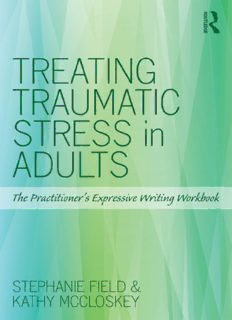
Treating Traumatic Stress in Adults: The Practitioner’s Expressive Writing Workbook PDF
Preview Treating Traumatic Stress in Adults: The Practitioner’s Expressive Writing Workbook
Treating Traumatic Stress in Adults Treating Traumatic Stress in Adults is a resource for therapists of all dis- ciplines for use in the treatment of adults suffering from post-traumatic stress. By reading this unique synthesis of information on the most current trauma treatments and expressive writing exercises, practitioners will gain an integrative and practical set of tools for treating post-traumatic stress. Also included are numerous diverse case vignettes, exercises for building trust in the patient/client relationship, and sections dedicated to exploring the client’s thought patterns and emotions to provide an opportunity for exposure, healing, and restructuring maladaptive beliefs. Stephanie Field, PsyD, is a licensed clinical psychologist at the Counseling and Psychological Services department at the University of Hartford and sits on the Board of Directors for the Connecticut Psychological Associa- tion. She has worked primarily with adults and young adults, specializing in substance use disorders, traumatic stress, and expressive writing therapy. Kathy McCloskey, PhD, PsyD, ABPP-CL, is a research psychologist, a licensed clinical psychologist, a Diplomate of the American Board of Profes- sional Psychology, and a professor at the University of Hartford Graduate Institute of Professional Psychology in Hartford, CT. She is the co-author of two books (Backs Against the Wall: Battered Women’s Resistance Strategies and A Sexuality and Gender Diversity Training Program), and has published over 70 peer-reviewed scholarly papers over her 30-plus year professional career. Her specialties include feminist psychology, multicultural and diver- sity issues, intimate partner violence, trauma, forensic populations, and the training of doctoral-level clinical psychologists. This page intentionally left blank Treating Traumatic Stress in Adults The Practitioner’s Expressive Writing Workbook Stephanie Field and Kathy McCloskey First published 2016 by Routledge 711 Third Avenue, New York, NY 10017 and by Routledge 2 Park Square, Milton Park, Abingdon, Oxon, OX14 4RN Routledge is an imprint of the Taylor & Francis Group, an informa business © 2016 Taylor & Francis The right of Stephanie Field and Kathy McCloskey to be identified as authors of this work has been asserted by them in accordance with sections 77 and 78 of the Copyright, Designs and Patents Act 1988. All rights reserved. No part of this book may be reprinted or reproduced or utilised in any form or by any electronic, mechanical, or other means, now known or hereafter invented, including photocopying and recording, or in any information storage or retrieval system, without permission in writing from the publishers. Trademark notice: Product or corporate names may be trademarks or registered trademarks, and are used only for identification and explanation without intent to infringe. Library of Congress Cataloging-in-Publication Data Field, Stephanie Leigh. Treating traumatic stress in adults: the practitioner’s expressive writing workbook / Stephanie Field and Kathy McCloskey. pages cm Includes bibliographical references and index. 1. Post-traumatic stress disorder—Treatment. 2. Psychic trauma—Treatment. I. McCloskey, Kathy A. II. Title. RC552.P67F53 2015 616.85′21—dc23 2015018305 ISBN: 978-1-138-89075-6 (hbk) ISBN: 978-1-138-89076-3 (pbk) ISBN: 978-1-315-71007-5 (ebk) Typeset in Sabon by codeMantra On that glad night in secret, for no one saw me, nor did I look at anything with no other light or guide than the one that burned in my heart. —St. John of the Cross, “The Dark Night” To the patient souls whose secrets are unwritten and unspoken. It is for those looking for their light at the edge of darkness to illuminate that which is hidden from others and most importantly from themselves. This page intentionally left blank Contents PART I Introduction: Integrating Expressive Writing Into Trauma-Related Treatment Approaches 1 Trauma and Its Effects 3 Implications for Treatment 10 PART II Current Treatments for Trauma 13 Discussion of a Multidimensional Model 23 Future Treatment: The Case for Including Expressive Writing 25 Expressive Writing as a Therapy Technique 31 Conclusion 39 PART III Expressive Writing Workbook 43 General Writing Guidelines 43 Structuring Client Writing Activities during Session 44 PART III-I Beginning Exercises 47 Section 1: Lists and Clusters 47 Section 2: Sentence Stems 56 viii Contents Section 3: Acrostics and Poems 66 Section 4: Five-Minute “Sprints” 73 PART III-II Intermediate Exercises 78 Section 1: Letters 78 Section 2: Obituaries and Eulogies 81 Section 3: Character Sketches 85 Section 4: Dialogues 88 PART III-III Advanced Exercises 91 Section 1: Narratives 91 Section 2: Essays and Compositions 96 PART III-IV Free-Writing Exercises 106 Exercise 1: Semiautomatic Writing 106 Exercise 2: Into the Stream 107 PART III-V Activity-Based Exercises 108 Section 1: Relaxation Exercises 108 Section 2: Guided Imagery 110 Section 3: Multimedia Activities 116 PART III-VI Outcome Measures 121 Rationale 121 Screen for Post-traumatic Stress Symptoms 121 Contents ix The Revised Helping Alliance Questionnaire (HAq-II) 121 Alternate Measures for the Assessment of Trauma Symptoms 122 Process 126 Appendix A: SPTSS 127 Appendix B: The Revised Helping Alliance Questionnaire (HAq-II) 129 References 133 Index 143
Description: